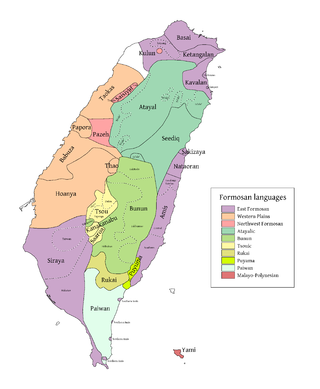Related Research Articles
The Manus languages are a subgroup of about two dozen Oceanic languages located on Manus Island and nearby offshore islands in Manus Province of Papua New Guinea. The exact number of languages is difficult to determine because they form a dialect continuum. The name Manus originally designated an ethnic group whose members spoke closely related languages and whose coastal dwellers tended to build their houses on stilts out over the sea.

Thao, also known as Sao, is the nearly extinct language of the Thao people, an indigenous people of Taiwan from the Sun Moon Lake region in central Taiwan. It is a Formosan language of the Austronesian family; Barawbaw and Shtafari are dialects.
Kiput is a Malayo-Polynesian language spoken in northern Sarawak, Borneo, Malaysia.
Proto-Austronesian is a proto-language. It is the reconstructed ancestor of the Austronesian languages, one of the world's major language families. Proto-Austronesian is assumed to have begun to diversify c. 4000 BCE – c. 3500 BCE in Taiwan.

Lun Bawang or Lundayeh is the language spoken by the Lun Bawangs. It belongs to the Malayo-Polynesian family.
The North Sarawakan languages are a group of Austronesian languages spoken in the northeastern part of the province of Sarawak, Borneo, and proposed in Blust.

Kelabit is one of the most remote languages of Borneo, on the Sarawak–North Kalimantan border. It is spoken by one of the smallest ethnicities in Borneo, the Kelabit people.
Lou is a Southeast Admiralty Islands language spoken on Lou Island of Manus Province, Papua New Guinea by 1,000 people.
The Nyindrou language is a West Manus language spoken by approximately 4200 people in the westernmost part of Manus Island, Manus Province of Papua New Guinea. It has SVO word order.
The Likum language is a West Manus language spoken by approximately 80 people in western Manus Island, Manus Province of Papua New Guinea. Its speakers also use Nyindrou. Likum is classified as "definitely endangered" by UNESCO's Atlas of the World's Languages in Danger. It has SVO word order.
Lele is an East Manus language of the Austronesian language family spoken in the northeastern part of Manus Island, New Guinea. It has an SVO word order.

The Hawu language is the language of the Savu people of Savu Island in Indonesia and of Raijua Island off the western tip of Savu. Hawu has been referred to by a variety of names such as Havu, Savu, Sabu, Sawu, and is known to outsiders as Savu or Sabu. Hawu belongs to the Malayo-Polynesian branch of the Austronesian language family, and is most closely related to Dhao and the languages of Sumba. Dhao was once considered a dialect of Hawu, but the two languages are not mutually intelligible.
The Bima language, or Bimanese, is an Austronesian language spoken on the eastern half of Sumbawa Island, Indonesia, which it shares with speakers of the Sumbawa language. Bima territory includes the Sanggar Peninsula, where the extinct Papuan language Tambora was once spoken. Bima is an exonym; the autochthonous name for the territory is Mbojo and the language is referred to as Nggahi Mbojo. There are over half a million Bima speakers. Neither the Bima nor the Sumbawa people have alphabets of their own for they use the alphabets of the Bugis and the Malay language indifferently.
Titan, also known as Manus, is an East Manus language of the Austronesian language family spoken in the southeastern part of Manus Island, New Guinea, and neighboring islands by about 4,000 people.
Saʼban is one of the remoter languages of Borneo, on the Sarawak–Kalimantan border. The language is known as hmeu Saʼban in the Saʼban language.
Lenkau is an Oceanic language spoken in a single village on Rambutyo Island in Manus Province, Papua New Guinea. It is spoken in Lenkau village, Rapatona Rural LLG.
Leipon, or Pityilu, is an Austronesian language spoken on Hauwai, Ndrilo, and Pityilu islands, just off Manus Island in Papua New Guinea.
Kurti is an Austronesian language spoken on the north coast of Manus Island in Papua New Guinea.
Old Tagalog, also known as Old Filipino, is the earliest form of the Tagalog language during the Classical period. It is the primary language of pre-colonial Tondo, Namayan and Maynila. The language originated from the Proto-Philippine language and evolved to Classical Tagalog, which was the basis for Modern Tagalog. Old Tagalog uses the Tagalog script or Baybayin, one of the scripts indigenous to the Philippines.

Rejang is an Austronesian language predominantly spoken by the Rejang people in southwestern parts of Sumatra (Bengkulu), Indonesia. There are five dialects, spread from mountainous region to the coastal region of Bengkulu, including the Musi (Musai) dialect, the Lebong dialect, the Kebanagung dialect, the Rawas (Awes) dialect, and the Pesisir dialect.
References
- ↑ Khehek at Ethnologue (18th ed., 2015) (subscription required)